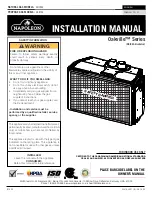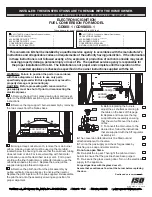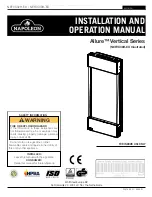
23466-4-0509
Page 8
SPECIFICATIONS
Model
(A)VFD26F(M,P)3 (A)VFD26F(M,P)2 (A)VFD26FP30L10
Input Maximum
20,000
20,000
10,000
Minimum
14,000
14,000
N/A
NAT
Orifice
2.10 mm (P-288)
#49 (.073") P-265
#53 (.0595") P-214
Air Shutter Opening
1/8"
1/8"
1/8"
Lp
Orifice
#55 (.052") P-182
#55 (.052") P-182
#64 (.036") P-193
Air Shutter Opening
Open
Open
Open
Fireplace Dimensions
Height
30 1/4"
30 1/4"
30 1/4"
Depth
13 1/8"
13 1/8"
13 1/8"
Front Width
30"
30"
30"
Rear Width
25"
25"
25"
Gas Inlet
3/8"
3/8"
3/8"
Accessories
FBBX
Blower Extension Kit (MUST order FBB4)
FBB4
Automatic Blower (MUST order FBBX)
VPS26HP
Bottom Trim Kit
VF2H26HP
Hammered Pewter Hood Kit
VPF26HP
Hammered Pewter Trim Kit
FPP26E
Brick Liner
VPL26HP
Hammered Pewter Slat Louver
Accessories for (A)VFD26F(M,p)3 Only
FRBC
Battery Operated Remote Control
FRBTC
Battery Operated Remote Control w/Thermostat
FREC
Electric Remote Control
FWS-1
Wall Switch
TMV
Wall Thermostat, Millivolt - Reed Switch
TRW
Wireless Remote Wall Thermostat
Water vapor is a by-product of gas combustion. An unvented room
heater produces approximately one (1) ounce (30ml) of water for
every 1,000 BTU's (.3KW's) of gas input per hour. .
Unvented room heaters are recommended as supplemental heat (a
room) rather than a primary heat source (an entire house). In most
supplemental heat applications, the water vapor does not create a
problem. In most applications, the water vapor enhances the low
humidity atmosphere experienced during cold weather.
The following steps will help insure that water vapor does not
become a problem.
1. Be sure the heater is sized properly for the application, including
ample combustion air and circulation air.
2. If high humidity is experienced, a dehumidifier may be used to
help lower the water vapor content of the air.
3. Do not use an unvented room heater as the primary heat
source.
WATER VAPOR: A BY-PRODUCT OF UNVENTED ROOM HEATERS









































